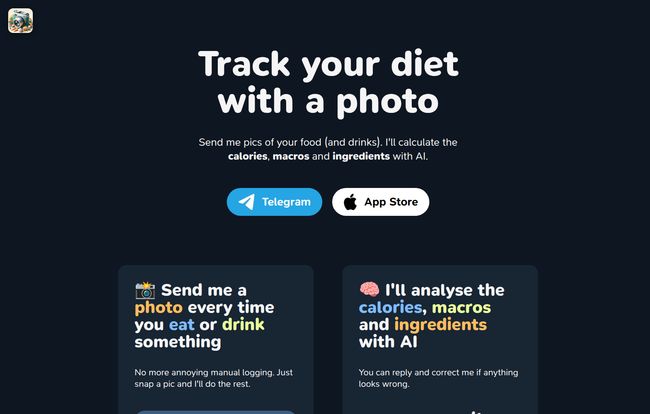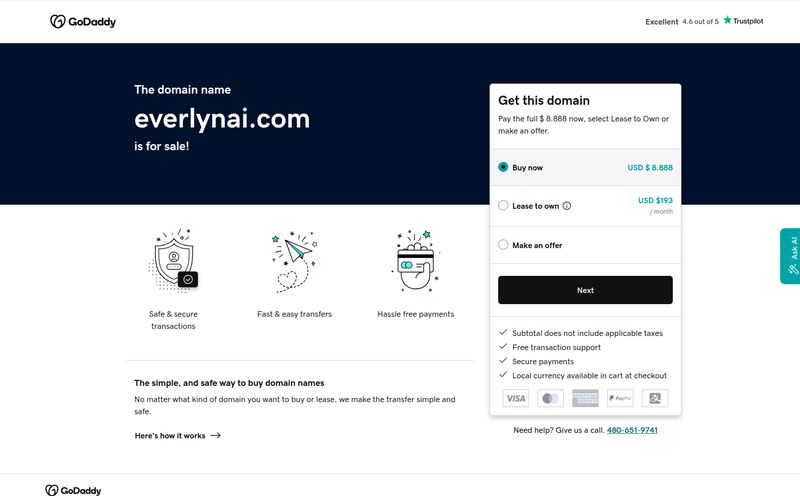If there’s one thing that can suck the joy out of a good meal, it’s the looming dread of having to log it. I’ve been in the digital marketing game for years, and I’ve seen my fair share of productivity and habit-tracking apps. But food logging... that’s a special kind of purgatory. You find yourself meticulously weighing a sad-looking chicken breast or endlessly scrolling through a database for “generic brand, whole wheat bagel,” only to give up and guesstimate anyway.
I’ve always felt there had to be a better way. A way that didn’t involve a digital food scale and a PhD in nutritional databases. So when I stumbled across Meals.Chat, my curiosity was definitely piqued. An AI-powered bot that lives in Telegram and promises to track your diet from a simple photo? It sounds like something straight out of a sci-fi movie. But is it the real deal, or just another tech gimmick?
I decided to put it to the test. For one week, I outsourced my dietary diligence to an AI. Here’s what happened.
What is Meals.Chat Anyway? An AI Diet Coach in Your Pocket
At its core, Meals.Chat is an AI assistant designed to simplify calorie and macro tracking. Instead of opening a clunky app, you just open a chat with the bot in Telegram—an app many of us already use daily. You can either snap a photo of your plate, your coffee, your late-night snack (no judgment), or just type out a quick description like “chicken salad with no dressing.”

Visit Meals.Chat
The AI then does its thing. It analyzes the image or text and pings you back with an estimate of the calories, protein, carbs, and fat. It’s built on the idea of removing friction. The less work you have to do, the more likely you are to stick with it. At least, that's the theory.
How Does This AI Magic Actually Work?
The process is refreshingly straightforward. It’s less like using a piece of software and more like texting a very knowledgeable, very nerdy friend who just happens to be a robot.
Taking a Picture is the New Logging
This is the headline feature, and honestly, it’s pretty cool. I started with a burger from a local joint. Snapped a pic, sent it off. A few moments later, ping. The bot returned: Calories: 563kcal, Protein: 30g, Carbs: 44g. It felt... effortless. For all those times you’re eating out and have no clue what’s in your food, this feels like a genuine step forward. It takes the burden of guesswork off your shoulders and puts it onto the AI's. A welcome change.
When a Photo Just Won't Do
The AI is smart, but it's not a mind reader. It can’t tell if your green smoothie has whey protein or if you asked for no dressing on your salad. That’s where text input comes in. You can either correct the AI's analysis or just describe your meal from the get-go. I found myself using this for simple things, like “one black coffee” or “handful of almonds.” It's fast, simple, and gets the job done without the fanfare of a photo.
Setting Your Sights on Goals
Meals.Chat isn't just a one-off calculator. You can set daily targets for your calories and macros (protein, carbs, and fat). The bot keeps a running tally for the day, so you can quickly check in and see how you’re doing. This is where it moves from a neat party trick to a genuinely useful tool for anyone trying to manage their intake, whether for weight loss, muscle gain, or just general health awareness.
My Honest Take After Kicking the Tires
So, after a week of snapping pics and texting a bot, what’s the verdict? Like any tool, it’s not perfect. But it has some surprisingly strong points that made me rethink my hatred of food logging.
The Stuff I Genuinely Liked
The biggest win for Meals.Chat is its convenience. Living inside Telegram means it’s always just a couple of taps away. There’s no new app to learn, no complicated interface. It lowers the barrier to entry so much that it almost feels lazy not to log something. That, right there, is a huge psychological victory.
And the automation! Not having to manually search for every single ingredient in my salad was a game-changer. The AI’s ability to break down a green juice into its components (spinach, banana, ginger, celery, according to its analysis) was impressive, even if the exact grammage was a guess.
One feature that really stood out was the caffeine tracking. As someone who mainlines coffee to get through long days of staring at Google Analytics and Search Console data, this was an unexpected bonus. Seeing my daily caffeine intake tallied up was a real eye-opener. A much-needed one, probably.
Where It Gets a Bit Murky
Now for the reality check. The biggest caveat here is accuracy. The numbers Meals.Chat gives you are estimates. Good estimates, most of the time, but still estimates. It’s not performing a chemical analysis of your food. I view it as a helpful guide for direction rather than a precise GPS for your nutrition. If you're a professional athlete or bodybuilder needing lab-grade precision, this probably isn't your tool.
Its effectiveness is also heavily dependent on the quality of your input. A clear photo of a steak, potatoes, and broccoli is easy for the AI to analyze. But my mom's mystery casserole? Good luck. Trying to get an AI to identify that delicious, amorphous blob is like asking a tourist for directions in my hometown—you'll get a confident answer, but it might not be right. For those complex, homemade meals, you'll still need to rely on text descriptions for better results.
Finally, the fact that it requires a Telegram account might be a hurdle for some. For me, it was a plus. For someone who doesn't use Telegram, being asked to download and sign up for a new messaging app just to track calories could be an annoyance.
Who is This Tool Really For?
After my week-long experiment, I have a pretty clear idea of the ideal Meals.Chat user. It’s for the busy professional, the student, the parent—anyone who wants to be more mindful of their eating habits without turning their life into a science experiment. It’s for the person who has tried and failed with traditional calorie-counting apps because the manual entry was just too tedious.
It’s a tool for awareness and trends. It’s less of a strict drill sergeant and more of a helpful spotter at the gym, giving you a nudge in the right direction. If you want to know if you're generally hitting your protein goals or see how much that daily pastry is really costing you in calories, it's brilliant.
Let's Talk Money: The Price of Convenience
This is often the million-dollar question. As of my review, Meals.Chat appears to be completely free to use. I couldn't find any pricing page or subscription tiers. Now, in the world of tech, “free” can sometimes be a temporary state. It’s possible they might introduce premium features down the line, perhaps for more detailed analysis or personalized coaching. But for now, you can get all this functionality without opening your wallet, which makes it a pretty compelling offer.
Frequently Asked Questions
Is Meals.Chat really accurate?
It's more directionally accurate than perfectly precise. It provides solid estimates that are great for tracking trends and maintaining general awareness of your diet. Don't expect it to be 100% correct down to the last calorie, especially with complex, homemade dishes.
Do I need to install another app on my phone?
If you already have Telegram, then no! It works right within the app you already use. If you don't have Telegram, you will need to install it. The landing page also shows an "App Store" button, suggesting a standalone app might be available or in the works for those who prefer that.
Can it track my workouts or water intake?
Based on all the available information, Meals.Chat is laser-focused on what you consume—food, drinks, and caffeine. It does not appear to have features for tracking exercise or water intake at this time.
How does it handle a complex meal like a stew?
This is where photo analysis can struggle. For something like a stew, casserole, or a complex curry, the AI will make its best guess. For better accuracy, it's recommended to use the text feature and describe the main ingredients, like "beef stew with potatoes and carrots."
What about caffeine from different sources?
The caffeine tracking is a great feature. You can tell it "one espresso" or "a can of diet coke," and it will log the estimated caffeine content, giving you a running total for the day. It’s a simple but effective way to monitor your stimulant intake.
Is my food data private?
This is a crucial question for any app that handles personal data. While I didn't conduct a full privacy policy audit, users should always exercise caution. It's wise to review the platform's privacy policy to understand how your data (including photos of your meals) is stored and used. You can usually find this on their website or within the app's settings.
Final Thoughts: Is It Worth a Shot?
Absolutely. For the low, low price of free, Meals.Chat offers a genuinely innovative solution to a problem many of us have struggled with for years. It successfully removes the biggest point of friction in diet tracking: the tedious manual logging.
It’s not a perfect system, and it won’t replace the need for precision for those with strict medical or athletic requirements. But for the vast majority of us who just want to eat a little better and understand our habits, it's a fantastic, modern tool. It’s a glimpse into a future where managing our health is less about chores and more about simple, smart conversations. And that's a future I'm excited about. Give it a try—you might be surprised how easy it can be to stick with it.
Reference and Sources
The official website and tool can be accessed via links on their landing page, though a direct public site was not apparent at the time of writing. The primary access points are via Telegram or the Apple App Store.
General information on the difficulty of manual calorie tracking can be found in discussions across health forums and publications like those from Harvard Health Publishing.



